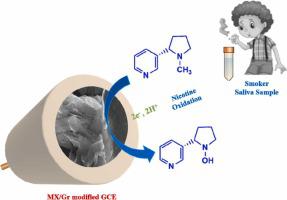Journal of Hazardous Materials ( IF 12.2 ) Pub Date : 2022-08-03 , DOI: 10.1016/j.jhazmat.2022.129705 Jerome Rajendran 1 , Ashok K Sundramoorthy 2 , Dhanraj Ganapathy 2 , Raji Atchudan 3 , Mohamed A Habila 4 , Deepak Nallaswamy 2

|
The quantitative analysis of neurological drugs is critical since the kinetics of body fluids is strongly dependent on the dosage of the drug levels. Thus, the study of neurological medicines is significant because of the major diseases connected to it, for instance, Alzheimer's and Parkinson's diseases. Herein, a 2D hybrid MXene/graphene (MX/Gr) film was synthesized through a top-down approach and utilized to prepare an electrochemical transducer for the electrochemical sensing of nicotine. The X-ray diffraction (XRD), Raman and X-ray photoelectron spectroscopy (XPS) confirmed the successful incorporation of MX with Gr sheets. The high-resolution scanning electron microscopy (HR-SEM) and transmission electron microscopy (TEM) have been used to confirm the formation of MX, graphene sheets and the MX/Gr hybrid film. Furthermore, the MX/Gr hybrid film composite modified glassy carbon electrode (GCE) was prepared to selectively detect the nicotine in phosphate buffer medium (0.1 M PBS, pH~7.4). Under the optimized condition, the MX/Gr/GCE based sensor provided a linear response against nicotine from 1 to 55 µM and 30 nM – 600 nM with the lowest limit of detections (LOD) of 290 nM and 0.28 nM by differential pulse voltammetry (DPV) and amperometry, respectively. This newly developed MX/Gr hybrid film modified electrode displayed a remarkable selectivity, sensitivity, and reproducibility for accurate detection of nicotine. Finally, this new sensor was applied to detect nicotine in human/artificial saliva samples with high accuracy.
中文翻译:

二维 MXene/石墨烯纳米复合材料的制备及其电化学性能对人体唾液中尼古丁水平的鉴定
神经药物的定量分析至关重要,因为体液的动力学很大程度上取决于药物水平的剂量。因此,神经学药物的研究意义重大,因为与它相关的主要疾病,例如阿尔茨海默病和帕金森病。在此,通过自上而下的方法合成了二维混合 MXene/石墨烯 (MX/Gr) 薄膜,并用于制备用于电化学传感尼古丁的电化学传感器。X 射线衍射 (XRD)、拉曼和 X 射线光电子能谱 (XPS) 证实了 MX 与 Gr 片材的成功结合。高分辨率扫描电子显微镜 (HR-SEM) 和透射电子显微镜 (TEM) 已用于确认 MX、石墨烯片和 MX/Gr 混合膜的形成。此外,制备了MX/Gr混合膜复合改性玻碳电极(GCE),用于选择性检测磷酸盐缓冲介质(0.1 M PBS,pH~7.4)中的尼古丁。在优化条件下,基于 MX/Gr/GCE 的传感器对 1 至 55 µM 和 30 nM - 600 nM 的尼古丁提供线性响应,差分脉冲伏安法的最低检测限 (LOD) 为 290 nM 和 0.28 nM ( DPV)和电流法,分别。这种新开发的 MX/Gr 混合膜修饰电极显示出卓越的选择性、灵敏度和重现性,可准确检测尼古丁。最后,这种新型传感器被应用于高精度检测人类/人工唾液样本中的尼古丁。pH~7.4)。在优化条件下,基于 MX/Gr/GCE 的传感器对 1 至 55 µM 和 30 nM - 600 nM 的尼古丁提供线性响应,差分脉冲伏安法的最低检测限 (LOD) 为 290 nM 和 0.28 nM ( DPV)和电流法,分别。这种新开发的 MX/Gr 混合膜修饰电极显示出卓越的选择性、灵敏度和重现性,可准确检测尼古丁。最后,这种新型传感器被应用于高精度检测人类/人工唾液样本中的尼古丁。pH~7.4)。在优化条件下,基于 MX/Gr/GCE 的传感器对 1 至 55 µM 和 30 nM - 600 nM 的尼古丁提供线性响应,差分脉冲伏安法的最低检测限 (LOD) 为 290 nM 和 0.28 nM ( DPV)和电流法,分别。这种新开发的 MX/Gr 混合膜修饰电极显示出卓越的选择性、灵敏度和重现性,可准确检测尼古丁。最后,这种新型传感器被应用于高精度检测人类/人工唾液样本中的尼古丁。这种新开发的 MX/Gr 混合膜修饰电极显示出卓越的选择性、灵敏度和重现性,可准确检测尼古丁。最后,这种新型传感器被应用于高精度检测人类/人工唾液样本中的尼古丁。这种新开发的 MX/Gr 混合膜修饰电极显示出卓越的选择性、灵敏度和重现性,可准确检测尼古丁。最后,这种新型传感器被应用于高精度检测人类/人工唾液样本中的尼古丁。











































 京公网安备 11010802027423号
京公网安备 11010802027423号